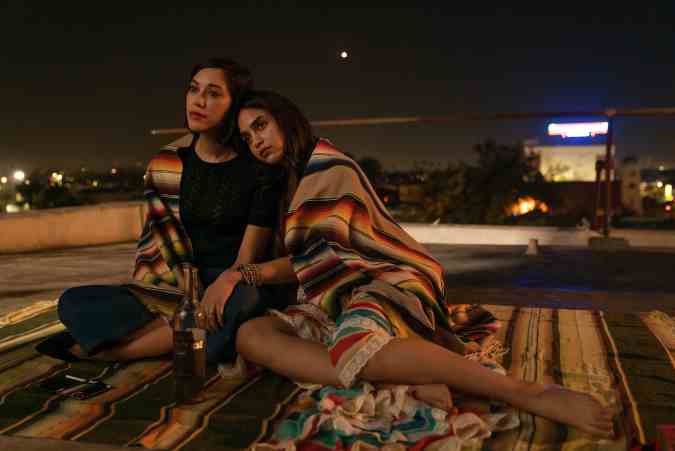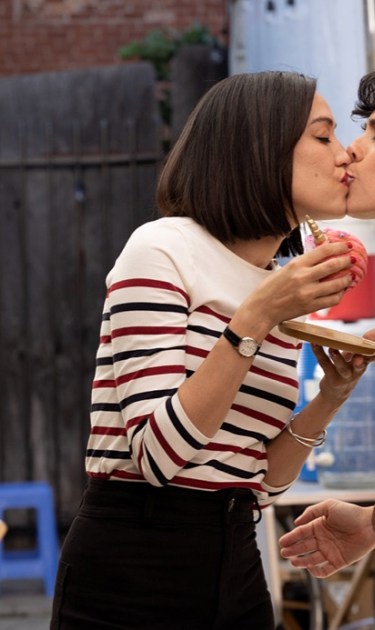Two women lay naked next to one another. Theirs is a known intimacy. They giggle and blush and kiss before the closely-handheld camera catches them playfully wrestling with one another in bed. Chavela Vargas’ “Macorina” scores their morning roughhousing: “Ponme la mano aquí,” she croons. Her order feels directed as much at both of these characters as to those of us watching. Eventually, one woman’s thigh reveals the title of the show we’re watching: Vida. Such a scene, already a celebration of same-sex intimacy, feels all the more radical in a post-COVID-19 world where such touching feels tinged with nostalgia and utopia alike.
The third and final season of Vida arrives in a different world than the one it’s depicting. Its concerns with desire, gentrification, community-building and sisterly love don’t necessarily date the show. But they place it squarely in a pre-pandemic world that already feels too remote for any of us to remember what it felt like. To see Emma (Mishel Prada) and Nico (Roberta Colindrez) frolicking in a bed completely entranced with one another’s bodies (and, over the course of the show’s final season, struggle with staying together amid the chaos around them) is to experience a world much simpler and more complicated than the one many of us are living nowadays.
Creator Tanya Saracho hopes the show will still be enjoyed even in such uncertain times. If anything, Vida‘s celebration of erotic intimacies gets her to think more about the future of television production in the near future. “I was watching the eighth episode from last season,” she tells Remezcla, “and everybody was kissing on the mouth to say hello. And I was like, I would never as a producer be able to do that now. Like, as a show runner how can you be like, Alright, so kiss each other all the time! Like, how are we gonna do sex scenes again? How are we gonna do any kind of those scenes? We’re gonna have to take note of the moment right now. But I don’t know what that does to us as a society. Like, are there no more sex scenes? Is it all gonna be like that movie Her?”

Such concerns may feel trite but they get at what’s made Vida such a vibrant show during its run. Its frank depiction of sexuality (in its many forms) as well as its tackling head on of taboos within the Latino community and across generations have made its sex scenes feel urgent. Necessary even. Sex, Vida has always stated, is not something incidental to our lives. Who we sleep with (and why and for how long, and on whose terms) is an important a concern for these Boyle Heights characters — one that plays off its other interests in colorism, gentrification, queer community, radical activism and even the conservative ideas of family it toys with.
Indeed, it’s those very Vida themes that feel all the more timely during this pandemic. “Everything that we thought was a certain way is no longer that way,” Prada tells Remezcla. “But I do think it ties into letting go, which is a big part of the third season. And letting things happen and trusting the river, in a way. And just taking what’s in front of you. I think Emma really tries to do that this season and we haven’t seen her doing that before. She’s got plans. She’s got a schedule; this is the way it’s gonna go. This third season definitely mirrors what we’re going in now which is that there are no plans to be made. You never know what’s going to happen and you just have to go with what’s in front of you and that’s it.”
For Melissa Barrera, who plays Emma’s free-spirited sister Lyn, even the show’s focus on two small business owners trying to salvage their titular bar, Vida,’ speaks even more urgently to today’s concerns. “The sisters have to lift it up from the ashes because they’re in debt,” Barrera tells Remezcla. “And they have to figure out a way to make it work. And I feel like a lot of people are going to be in that position when this is all over. A lot of people are going to be struggling with their businesses that have been closed for months and figuring out how to build them back up again. I feel like viewers might relate even more to this to the story and to the sisters and how they try to make it work.”
The final season of Vida, in keeping with the show’s sensibility, is a radical re-imagining of what queer Latina stories can look like — something that feels even more pressing as queer communities of color continue to bear the brunt of the Coronavirus epidemic. If, as Vargas sings in “Macorina,” bodies are flags, then to watch Vida in the age of Corona is to see a glimmer of hope in the horizon, a symbol of a queer nation still being imagined in spite of all the chaos around it.
Vida’s third and final season airs Sundays at 9 p.m. on Starz




